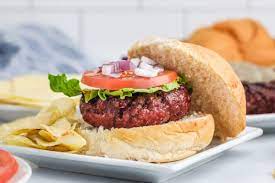Are you aware that hamburgers are one of the most popular foods in the United States, with Americans consuming over 50 billion burgers each year? Now, imagine being able to enjoy this beloved classic without any guilt or compromise on your health. Well, we have some great news for you. In this article, we will reveal the healthiest way to cook hamburger meat, ensuring that you can relish the mouthwatering flavors while still making nutritious choices. So, get ready to discover the secrets to creating a burger that not only satisfies your taste buds but also supports your well-being.
Choosing Leaner Meat Options
To choose leaner meat options, opt for ground beef that meets specific criteria for fat, saturated fat, and cholesterol content. Look for grass-fed beef, which offers additional health benefits such as higher antioxidant content and a healthier fatty acid profile. If you’re open to alternatives, consider incorporating plant-based options like turkey, chicken, bison, fish, or even vegetarian burgers made from legumes or grains. To enhance the nutritional value of your burger, try adding quinoa to the mixture for its high protein and fiber content. When it comes to toppings and condiments, opt for fresh vegetables like lettuce, tomato, onion, bell peppers, or grilled eggplant/zucchini. Instead of high-fat sauces or condiments, use herbs, spices, and low-sodium seasoning blends for flavor. Healthier options include avocado, guacamole, or low-fat cheese. And don’t forget to use cooking spray to prevent sticking and reduce the need for excess oil or fats. By making these choices, you can enjoy a healthier and more nutritious burger without sacrificing taste.
Healthy Toppings and Condiments
When it comes to adding flavor to your burger, opt for healthy toppings and condiments that enhance both taste and nutritional value. Here are some options to consider:
1) Grilled vegetable toppings: Instead of reaching for high-calorie and high-fat toppings, try adding grilled vegetables like bell peppers, onion, or zucchini. They add a burst of flavor and provide essential vitamins and minerals.
2) Homemade low sodium sauces: Skip the store-bought sauces that are often loaded with sodium and make your own healthier versions. Use fresh herbs, spices, and low-sodium seasoning blends to add flavor without the excess salt.
3) Avocado as a nutritious topping: Avocado is not only creamy and delicious, but it also provides healthy fats, fiber, and various vitamins and minerals. Slice it up and add it to your burger for a nutritious and satisfying topping.
4) Whole foods condiments: Explore whole foods like salsa, Greek yogurt, or homemade spreads as condiments for your burger. They are flavorful and provide additional nutrients compared to traditional high-sugar and high-sodium condiments.
Additionally, consider lean turkey as an alternative to beef for a lower saturated fat content. By choosing these healthier toppings and condiments, you can enjoy a flavorful and nutritious burger without sacrificing your health goals.
Cooking Techniques and Enhancing Flavor
Enhance the flavor of your burger and cook it to perfection with these cooking techniques. When grilling your burger, there are a few tips to keep in mind. First, reduce the fat content by choosing lean ground beef or alternative meats like turkey or chicken. You can also add moisture and nutrients by mixing in grated zucchini, carrots, or cooked quinoa. To enhance the flavor, season your burger with herbs, spices, garlic, onions, or Worcestershire sauce. Don’t be afraid to experiment with different types of mustard or hot sauces for an extra kick. If you’re looking for healthier seasoning options, try low-calorie or homemade dressings instead of high-fat mayonnaise. Remember to use cooking spray to prevent sticking and cook the burgers on a low flame, flipping them frequently to prevent the formation of harmful compounds. And finally, let the burgers rest for a few minutes before serving to allow the juices to redistribute. By following these cooking techniques and incorporating flavor-enhancing ingredients, you can enjoy a delicious and healthier burger.
Making Healthier Choices When Dining Out
When making healthier choices for your burger preparation at home, it’s important to extend those choices to dining out as well. Here are some tips to help you make healthier choices when dining out:
- Reducing calorie intake: Look for restaurants that offer lean or grass-fed beef options. Leaner cuts of meat can help reduce calorie intake and saturated fat content.
- Portion control: Ask for smaller portion sizes or share a burger with someone else. This can help prevent overeating and reduce calorie intake.
- Healthier condiment options: Opt for fresh vegetables like lettuce, tomato, onion, bell peppers, or sprouts as toppings. Use herbs, spices, and low-sodium seasoning blends for flavor instead of high-fat sauces or condiments. Consider avocado, guacamole, or low-fat cheese as nutritious toppings.
- Veggie burger alternatives: Explore restaurants that offer veggie burger options. These alternatives can be lower in saturated fat and calories compared to traditional meat burgers.
Additionally, be mindful of your beverage choices. Opt for water or diet soda instead of sugary sodas to reduce calorie intake. Making healthier choices when dining out can help you maintain a balanced and nutritious diet while still enjoying a burger.
Healthy Sides to Accompany Your Burger
To enhance your burger experience, consider incorporating healthy sides that will complement the flavors and provide additional nutrition. Instead of traditional French fries, opt for grilled vegetable skewers or sweet potato wedges. Grilling vegetables not only adds a delicious smoky flavor but also retains their nutrients. Quinoa salad is another excellent choice, packed with protein and fiber. Mix cooked quinoa with fresh vegetables like cherry tomatoes, cucumbers, and bell peppers, and toss with a light vinaigrette dressing. For a tropical twist, try grilling pineapple rings to serve alongside your burger. The natural sweetness of the pineapple pairs perfectly with the savory flavors of the burger. If you’re looking for a simple and nutritious option, steamed broccoli is a great choice. It’s rich in vitamins and minerals and adds vibrant color to your plate. By choosing these healthy sides, you can create a well-balanced meal that satisfies your taste buds and nourishes your body.
Enhancing the Ground Beef
For a juicier and healthier option, blend lean ground beef with sautéed or roasted mushrooms and onions. This not only adds moisture to the meat, but it also adds flavor and nutrients. Here are some other ways to enhance your ground beef:
- Blending mushrooms: Mix finely chopped mushrooms with the ground beef to add moisture and enhance the flavor without adding extra calories or fat.
- Using bulgur wheat: Replace 20% of the meat with cooked cracked bulgur wheat for a similar texture and a healthier option. Bulgur wheat is packed with fiber and nutrients.
- Adding grated vegetables: Incorporate grated zucchini or carrots into the ground beef mixture. This not only adds moisture but also boosts the nutritional value of your burger.
- Incorporating quinoa or lentils: Mix cooked quinoa or lentils into the ground beef to increase the fiber and protein content. This adds a hearty texture and makes your burger more filling.
Don’t be afraid to experiment with different toppings to add even more flavor and nutrition to your burger. Try adding fresh avocado, grilled pineapple, roasted peppers, caramelized onions, or grilled zucchini. The possibilities are endless!
Choosing a Healthier Bun
If you’re looking to make your burger even healthier, the next step is to consider choosing a healthier bun option. There are several ways you can reduce your carb intake and explore gluten-free options when it comes to your burger bun. One option is to try alternative breads, such as whole-grain buns or whole wheat pitas, which provide added fiber and nutrients. Another option is to experiment with lettuce wraps, using sturdy leafy greens like collards or romaine lettuce as a bun replacement. This can significantly reduce the carb content of your burger while adding a refreshing crunch. If you’re looking for a unique bun alternative, you can also try using portobello mushroom caps, which provide a meaty texture and additional nutrients. Additionally, whole grain tortillas can be a great alternative to traditional buns. By incorporating these healthier bun options, you can enjoy your burger while making smarter choices for your overall health.
Safe Grilling Techniques
Grill your burgers safely by following these evidence-based, practical tips to reduce the formation of harmful compounds and ensure proper cooking:
- Reduce carcinogen formation: High-temperature cooking methods like grilling can increase the formation of compounds that may increase cancer risk. Keep the flame low and flip burgers frequently to prevent the formation of these compounds. Cook most of the burger on the side of the grill away from direct flame to reduce exposure to harmful compounds.
- Use herbs to inhibit compounds: Add herbs and spices like thyme, black pepper, ginger, garlic, or rosemary extract to inhibit the development of harmful compounds. These natural ingredients can help reduce the formation of carcinogens during grilling.
- Marinating to reduce harmful compounds: Marinating the meat before grilling can also help reduce the formation of harmful compounds. Use marinades that contain acidic ingredients like lemon juice or vinegar, as they can decrease the formation of harmful compounds during cooking.
- Proper cooking temperatures: Use a meat thermometer to ensure beef burgers reach a minimum internal temperature of 160°F to destroy harmful bacteria. Turkey and chicken burgers should be cooked to a minimum internal temperature of 165°F. Avoid pressing down on the burgers while cooking to retain moisture. Let the burgers rest for a few minutes before serving to allow the juices to redistribute.

